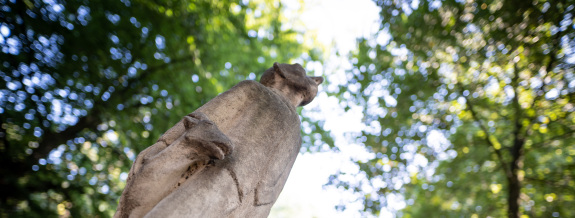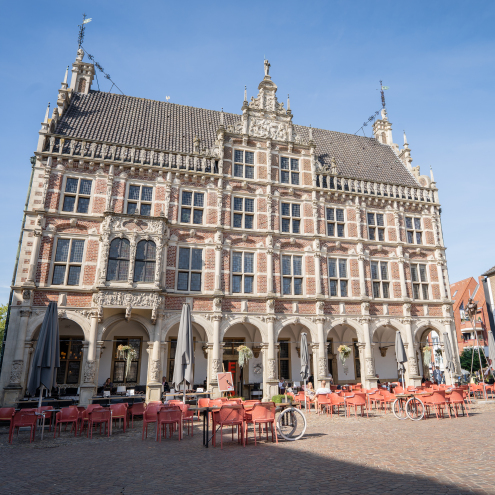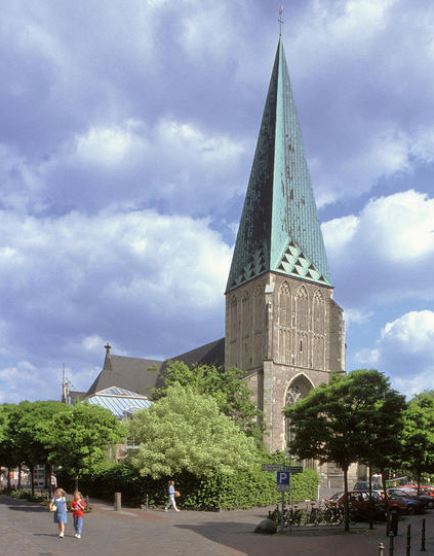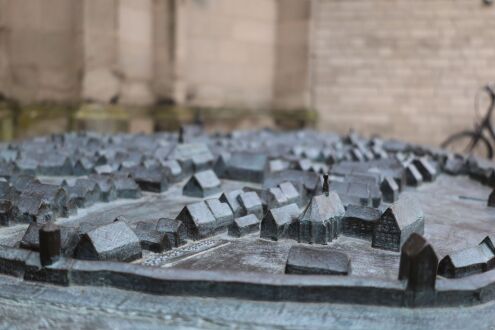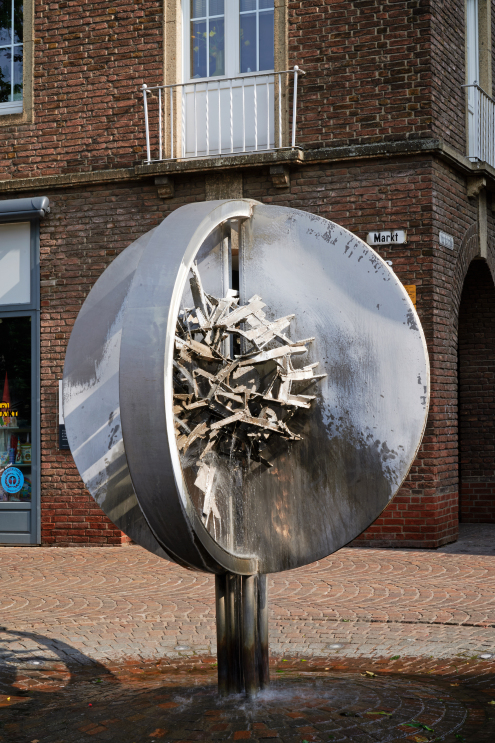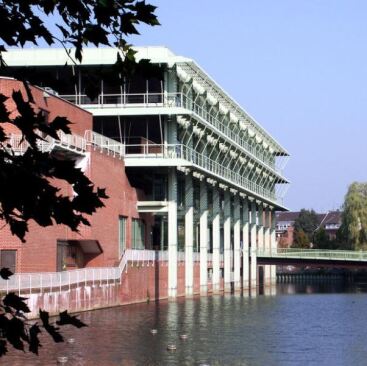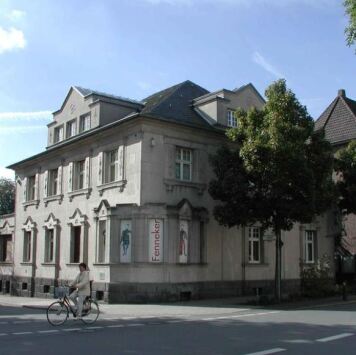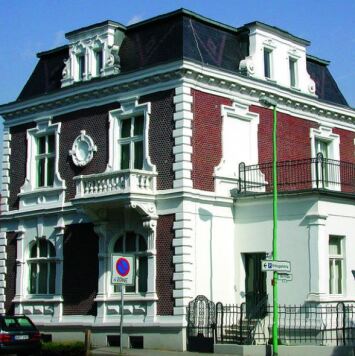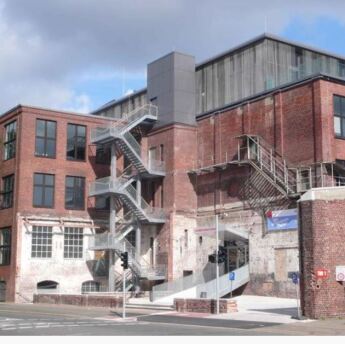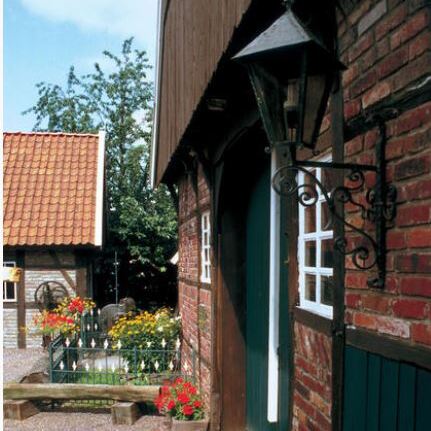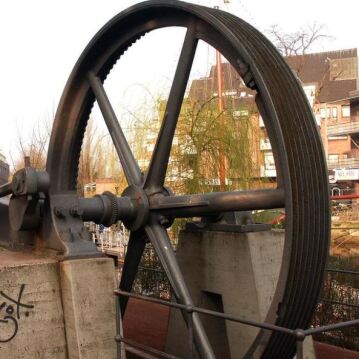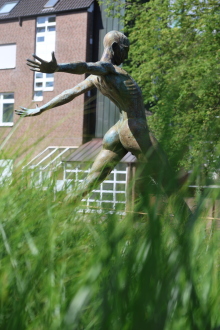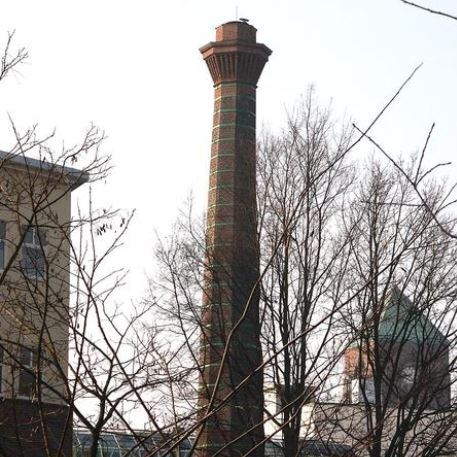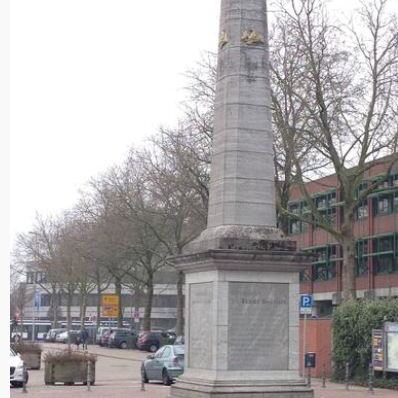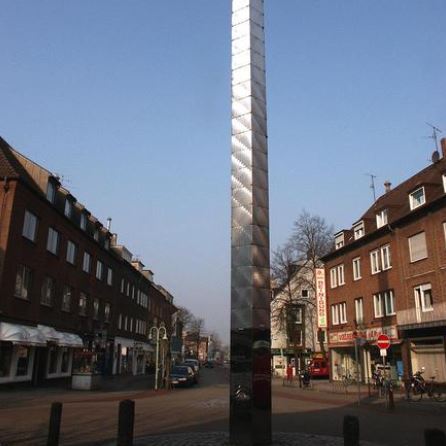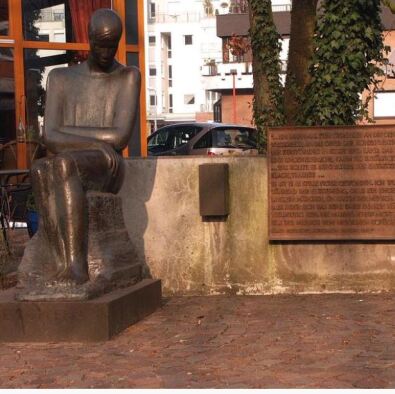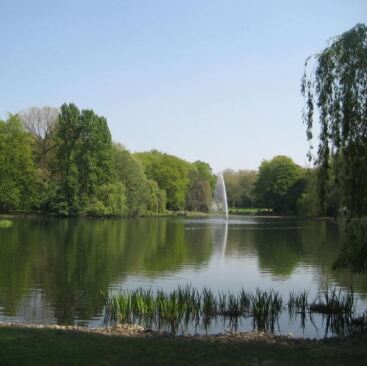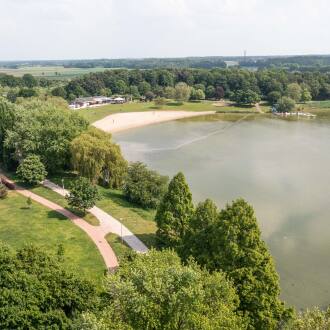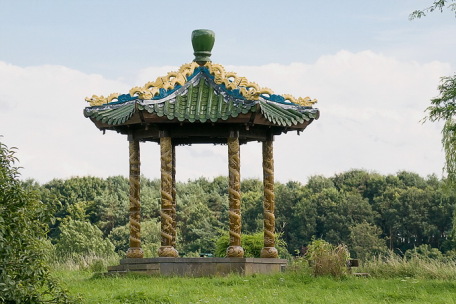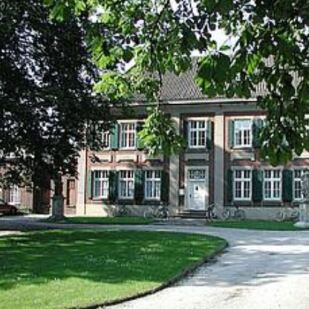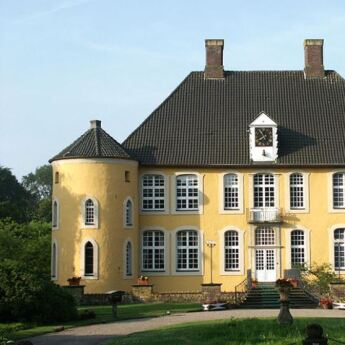Places of interest
Historic Town Hall
The city's landmark, built 1618-1624 in Dutch Reanaissance style. Destroyed and rebuilt after the end of the Second World War. Together with St. George's Church, the oldest building in Bocholt, the Historic Town Hall on the market square forms the centre of the town. The wedding room is a popular place to get married.
St. George Church
St. George's Church is the first parish church in the town. It is considered one of the oldest and most important church buildings in Westphalia. The foundation stone was laid in 1415 and the church was completed in 1486.
Model of the town of Bocholt around 1822
A bronze model of Bocholt has stood on St Georg Square, between the historic town hall and St Georg Church, since the 800th anniversary of the town in 2022. The artist Egbert Broerken created the detailed depiction of the city around 1822 with its outlines and striking buildings.
The model is barrier-free and can also be touched by blind people. An accompanying plaque provides information about important stages in the town's history - from the first mention of Bocholt in 779 to the derivation of its name("buocholt" for Buchenwald) and the founding of the town in 1222.
Europe Fountain
Bocholt was awarded the honorary title of "Community of Europe" in 1972, followed by the European flags and the designation "European City". The awarding of the title was the reason for the creation of the European Fountain in front of the historic town hall. Artist Friederich Werthmann designed the steel sculpture for the 750th anniversary celebrations. He used a sphere in openwork form to symbolise the globe. It symbolises the globe, the disc of the earth and the ring of the sun.
New Bocholt Town Hall
Bocholt, the town with two town halls. On Berliner Platz there is a town hall built in the seventies with a cultural centre and theatre. It is the seat of the administration. (Note: The town hall is currently being renovated, as of 11/2022).
The well-known Cologne architect Gottfried Böhm was awarded the Pritzker Prize for this town hall.
Bocholt City Museum
As a museum of history, art and folklore, the Bocholt City Museum is an important source of information on the history and culture of the Bocholt region.
The museum houses the valuable art collections of the engraver Israhel van Meckenem (15th century engraver) and the estate of the stage designer Josef Fenneker.
Important note: The museum is currently closed due to renovation work. Please check the museum's website for the latest information.
Bocholt House of Art
An art centre has been housed at Osterstraße 69 since 1996. The neo-Renaissance-style villa has been restored by the owner - the Stadtsparkasse Bocholt Foundation for the Promotion of Science, Culture and Environmental Protection - and rented to the city of Bocholt. The Kunsthaus is a venue for contemporary art exhibitions.
LWL-Museum Textilwerk with weaving mill and spinning mill
Discover the textile industry of the 20th century: The LWL-Museum Textilwerk of the Landschaftverband Westfalen-Lippe in Bocholt was opened in 1989 as a museum factory modelled on historical examples.
A boiler house with chimney, a machine house, a production hall with shed roofs, workshop, offices, warehouse, gatehouse and porter's lodge, coach house, railway track and workers' houses are home to a Münsterland weaving mill from the turn of the century.
The building of the former Herding spinning mill (photo) was added in 2011. The building with more than 4,000 square metres offers space for exhibitions, collections and events.
Large special exhibitions show the interaction between social developments, fashion and clothing
Crafts Museum Bocholt
The Crafts Museum was created on the private initiative of master carpenter Walter Dues. Over five decades, Dues has collected old tools, aids, equipment, books and drawings that bring the art of craftsmanship to life.
In a half-timbered house, visitors are given an insight into the workshops of carpenters, joiners and the like.
22 different trades can be seen in the museum with their tools and work results.
Parish Church of Our Lady
The Liebfrauen parish church is a Catholic parish church, formerly the monastery church of the Minorites, built between 1785 and 1792 in the late Baroque style. The church was extended between 1912 and 1913 and was planned as the town's second parish church after St George's Church around 1310. The building was completed in 1316.
Historic steam engine "Fuckepott"
The historic steam engine, popularly known as "Fuckepott", is located near the shopping arcades. It is one of the few remaining steam engines in Germany with its core still intact.
In 1972, the demolition hammer hovered over a relic from the early days of the steam engine era, which had been preserved on the Ostwall on the site of the former Tacke & Piekenbrok weaving and roasting mill. Today it is a reminder of the age of industrialisation with a once flourishing textile industry in Bocholt.
Bronze sculpture "Défi"
A life-size, naked male body in a horizontal, almost flying pose: the bronze figure by French artist Nicolas Lavarenne seems to rhythmically push off from the ground or float in balance over a narrow edge or pole - an expression of strength, effort and lightness at the same time.
The eye-catching sculpture on the Aa promenade, near Neutorplatz, is reminiscent of the open-air art exhibition in the summer of 2022, when over 20 Lavarenne artworks were on display as part of the 800th anniversary of the city of Bocholt.
Lavarenne's monumental sculptures have made him famous far beyond France.
Historic masonry chimney
The masonry chimney is an industrial monument near the shopping arcades. The 32-metre-high relic from 1857, the age of industrialisation, is octagonal in shape with iron bands on a square base.
Obelisk
The obelisk in front of the town hall on Berliner Platz is a replica of a Prussian milestone on Berliner Platz, built in 1985. 470 kilometres to Berlin from its location. For a long time, Berliner Platz was a "symbol of post-war urban development" and was thus characterised by sober reconstruction.
Light stele
The light column on Ravardistraße is an approximately 17 metre high concrete pillar. The multifaceted reflections of light from the aluminium cladding are striking. The light stele was built in 1984 by the artist Prof Heinz Mack.
Due to the constantly changing reflections of light, the work of art can be seen from afar and changes colour depending on the time of day.
South Bridge Memorial
The memorial on the South Bridge was created in 1970 by the Israeli sculptor Ellen Bernkopf. The memorial commemorates the victims of the two world wars and the concentration camps.
The warning is not to forget what man can inflict on man: "... A memorial to commemorate the fallen of both world wars, the victims of the concentration camps and the destruction in the city and the country seemed to me to be a monstrous, almost unmanageable task..."
Bocholt city forest
A green oasis in the city: several attractions make it a forest with recreational value. Ponds, walking trails, animal enclosures with wild boar, fallow deer, red deer, goats and sheep, a large playground, a Wild West-style steak restaurant and the toboggan hill are all great places to visit. There is also a popular exercise trail with three running routes of different lengths.
Aasee Bocholt
Nature experience and local recreation at the Aasee with many play and sports facilities. Swimming, surfing, sailing, running, Nordic walking, adventure playground, catering and more - the Aasee offers many opportunities for recreation.
The Aasee bathing bay with sunbathing lawn offers bathing fun on hot summer days.
The Aasee also has a leisure centre with mini-golf, skating track, skateboard ramp, sports fields, climbing fun (low ropes course) and skateboard hall. An attractive excursion destination for young and old and a favourite meeting place for kids.
Chinese Pavilion
A Chinese pavilion has stood on an island on Lake Aa in Bocholt
has been home to a Chinese pavilion since 2001. It comes from China and is a gift from the city of Wuxi, which has been friends with Bocholt since 1985. It has deliberately given this special gift to the citizens of Bocholt, who have built up and cultivated a wide range of economic, cultural and private links over the past decades. At the time, the pavilion was delivered in around 1,000 individual parts and had to be painstakingly put together. In the Feng Shui calendar, the year 2001 was a "time for the creation of beauty" and 24 September was "no day for business". The then President of the German-Chinese Society Bocholt e.V., Hans-Josef Dahlen, therefore chose precisely this day for the inauguration of the pavilion. A similar model can also be found in Wuxi on Tai Hu Lake.
Efing Manor House
The Efing manor house (Kornbusch) is located to the north-west of the town. It is a two-storey manor house, dated 1665 and 1965, with a high mansard roof. A sturdy octagonal stair tower stands at the main front. The house is now surrounded by housing estates.
Woord Manor House
The Woord manor house was built between 1792 and 1795. It is located at Münsterstraße 13 and is a two-storey manor house made of brick and stone with a hipped roof. It was extended in 1934. After being destroyed in the war, the manor house was rebuilt in its old form and the outbuildings in a modified form.
Diepenbrock Castle
Diepenbrock Castle is located in the Barlo district. It is an old knight's seat, first mentioned in 1326 as an Arnhem fief in the possession of the Lords of Diepenbrock.
The rectangular two-storey manor house with a high hipped roof and round towers on the south-west and north-east corners consists of four sections built between the 15th and early 17th centuries.
The castle park is home to rare and remarkable trees. The water feature on a quarry is also striking.
Diepenbrock Castle is privately owned. It is therefore only possible to visit the exterior.



